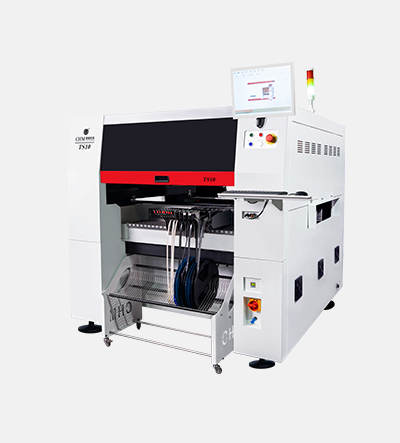Assessing Production Requirements for SMT Manufacturing
Understanding Board Size and Substrate Handling Needs
The dimensions of Printed Circuit Boards (PCBs) are pivotal when selecting pick and place machines for SMT manufacturing. The board size determines the machine’s ability to handle the substrate, which is a crucial factor in achieving efficient production. For example, if the board size exceeds the machine’s handling capacity, this could limit production speed and flexibility. Substrate handling involves considering both rigid and flexible substrates, each affecting equipment choice. Rigid substrates require machines with robust fixture capabilities, while flexible substrates demand adaptable handling features. This differentiation influences the selection of individual components and their placement, ensuring the chosen machine can support specific needs efficiently.
Matching Machine Capacity to Production Volume
Production volume significantly impacts the selection criteria for machine speed, feeder capacity, and overall efficiency in SMT manufacturing. High-volume production environments require scalable solutions that can accommodate increasing demands without compromising throughput. For example, machines with higher feeder input and slot capacity can handle a greater variety of components, ensuring smoother operations. Industry statistics indicate a growing demand for scalable solutions, emphasizing the need for machines that can adapt to varying production scales. By matching machine capacity with production volume requirements, manufacturers can achieve the optimal balance between speed, efficiency, and flexibility, thus maximizing productivity and profitability.
Identifying Component Types and Packaging Standards
Understanding component types and packaging standards is essential for effective pick and place operations. Components are generally categorized as through-hole or surface mount, each affecting the equipment setup. Surface mount technology typically requires machines with specific placement and handling capabilities tailored to these components. Additionally, packaging standards, as outlined by IPC guidelines, dictate how components are stored, transported, and placed, influencing machine settings and feeder configurations. For instance, tape-and-reel packaging might demand additional feeder slots or specific machine adaptations to accommodate varied component sizes and quantities. Adhering to these standards ensures seamless integration and optimized performance in SMT manufacturing processes.
Evaluating Pick and Place Automation Capabilities
Throughput Rates vs. Actual Production Speed
Throughput rates define the number of components a pick and place machine can handle per hour, but actual production speed often differs due to variables like machine setup and operator efficiency. For instance, while the theoretical throughput of a pick and place machine might be 200,000 components per hour, real-world conditions such as feeder jams and component misalignment can slow actual operations. A case study from Neoden USA highlights such discrepancies, emphasizing the importance of aligning expectations with practical outcomes and allowing for contingencies in planning. All these highlight the necessity of constant monitoring and adjustments in SMT manufacturing processes.
Manual vs. Automated Feeder Systems
Comparing manual and automated feeder systems reveals distinct advantages and disadvantages in production efficiency and cost implications. Manual feeders, although cheaper initially, increase operational labor costs and expose the process to human error, whereas automated feeders enhance accuracy and consistency while speeding up operations. Industry experts suggest automated feeders significantly boost efficiency, with surveys indicating a reduction in errors and labor costs. For many manufacturers looking to optimize pick and place automation, investing in automated feeders disrupts the conventional workflow positively.
Impact of Downtime on Line Efficiency
Downtime, whether due to equipment failure or necessary maintenance, drastically affects the overall efficiency of SMT production lines. A single hour of downtime can cost producers thousands in lost productivity and delayed targets. Strategies to minimize downtime include routine preventive maintenance, which ensures machinery remains in optimal condition, and implementing detailed performance metrics to anticipate potential failures before they occur. These approaches can reduce downtime-related losses and help maintain production continuity, critical for meeting rigorous industry demands. Regular maintenance can also support optimal machine performance and safeguard production targets.
Finally, as we assess the production requirements for SMT manufacturing, it becomes evident how critical it is to evaluate different aspects like board size, machine capacity, and component types. Understanding these factors allows us to create tailored solutions to enhance operational efficiency and meet market demands effectively. Be sure to keep these evaluations in mind when considering adjustments or upgrades to your SMT manufacturing processes.
Analyzing Machine Specifications for Precision Work
Vision System Quality for Fine-Pitch Components
The quality of a vision system is crucial in ensuring the accurate placement of fine-pitch components in SMT manufacturing. Vision systems use advanced technology to detect and correct misplacements, enhancing the precision and efficiency of pick and place machines. Technological advancements such as high-resolution cameras and sophisticated algorithms have significantly improved vision systems, allowing them to identify subtle errors and make real-time adjustments. For instance, a system that utilizes geometrical pattern recognition can maintain high levels of accuracy, even with components that have close tolerances.
Repeatability vs. Placement Accuracy Metrics
In the realm of SMT manufacturing, understanding the distinction between repeatability and placement accuracy is vital. Repeatability refers to a machine's capability to place components consistently at the same location under identical conditions, while placement accuracy involves how close the placed component is to its intended position. Both metrics are important, but repeatability often stands out as a key performance indicator. Industry benchmarks suggest that a high repeatability rate is more beneficial for maintaining quality, as it ensures consistent production results over time—thereby affecting overall manufacturing quality and efficiency.
Rotational Tolerance Requirements
Rotational tolerance in pick and place automation is essential for components with angular dependencies, such as those with connectors or orientation-specific features. This requirement becomes critical as components must fit precisely onto their designated spots without rotational misalignment. Manufacturers should adhere to engineering best practices, ensuring machines are equipped with rotational accuracy capabilities that align with established tolerancing guidelines. Such measures prevent defects and ensure that even the most complex assemblies are accurately produced, thus enhancing the overall quality of the manufacturing process.
Software and Integration Considerations
Programming Flexibility for Mixed Production
In today’s dynamic manufacturing environment, programming flexibility is paramount, especially for industries engaging in mixed production runs. When a pick and place machine needs to handle diverse components from various production lines, the ability to quickly and easily reprogram the machine becomes crucial. Modern software solutions for these machines offer intuitive, user-friendly interfaces that make it easier for technicians to adjust programming parameters efficiently. For example, Siemens and Beckhoff provide software platforms that support easy transition between different product setups, minimizing downtime and optimizing efficiency. Their platforms emphasize drag-and-drop features that allow operators to alter machine settings swiftly, facilitating seamless production changes.
Compatibility with Existing SMT Line Equipment
Ensuring seamless integration of new pick and place machines with existing SMT line equipment is essential to avoid unnecessary and costly upgrades. Compatibility ensures that all components of a production line communicate effectively and function in harmony, which reduces the risks of production downtimes. To assess compatibility during equipment selection, it's important to thoroughly review technical specifications and interface requirements. Companies should conduct compatibility checks, often facilitated by manufacturers, to ensure that new equipment can seamlessly integrate with legacy systems. Additionally, consulting with vendors to understand potential integration challenges can preemptively address any issues that may arise.
Future-Proofing with Upgradable Features
When investing in pick and place automation, future-proofing should be a core consideration. This involves selecting machines that not only meet current needs but are also equipped with upgradable features to accommodate evolving technological advances. As industry trends lean towards smarter and more interconnected manufacturing systems, machines that offer modular upgrades, such as enhanced software capabilities or additional tooling options, can provide long-term value and adaptability. Staying abreast of industry trends, such as the increased use of artificial intelligence in production lines, highlights the necessity for adopting equipment that can integrate these advancements, ensuring sustainability and competitiveness over time.
Vendor Support and Service Reliability Factors
Training Programs for Smooth Implementation
Vendor support through comprehensive training programs is crucial for the smooth implementation of pick and place machines. Such programs ensure that the operators understand the equipment thoroughly, leading to efficient operations and fewer errors. Companies often benefit from vendors that provide detailed training sessions at both the supplier and user sites, ensuring a holistic understanding of both the equipment and the surface mount technology (SMT) process. For instance, vendors with high ratings often offer not just equipment-specific training but also courses on broader SMT processes, greatly aiding in adoption and minimizing defects. As outlined by industry experts like Ray Prasad, effective training is vital in honing the skills necessary for high-precision operations in pick-and-place automation.
Maintenance Response Time Guarantees
The impact of maintenance response times on production efficiency cannot be overstated. Vendors' guarantees in this regard are vital for ensuring minimal downtime, thereby maintaining production continuity. In the competitive SMT manufacturing sector, where every minute of production counts, having a vendor who guarantees swift maintenance response can significantly enhance productivity. Industry standards suggest that robust service agreements with clear response time benchmarks should be a key consideration when choosing a vendor. These guarantees not only bolster service reliability but also provide peace of mind, knowing that swift action is taken whenever issues arise with the pick and place machine, ensuring optimal production flow.
Assessing Manufacturer Longevity in SMT Sector
When selecting equipment, assessing a manufacturer's longevity in the SMT sector is an important step to ensure vendor reliability. This involves evaluating their reputation, market share, and innovation track record. Companies with a long-standing history in the industry, like those frequently referenced by SMT consultants such as Ray Prasad, typically offer more stable and reliable investments. Established manufacturers are known to consistently deliver machines that meet evolving technological demands, thus providing stability and trust in an ever-changing market. Key factors such as a robust product line, continued innovation, and reliable customer support contribute to a manufacturer's longevity, ensuring that investment in their equipment is both sound and sustainable.
Introducing Hunan Charmhigh Electromechanical Equipment Co., Ltd.
Hunan Charmhigh Electromechanical Equipment Co., Ltd. is a reputed name in the field of pick and place machines, offering innovative solutions tailored to diverse SMT manufacturing needs. Their product line encompasses a range of advanced pick and place equipment designed to boost production efficiency and accuracy. With a focus on integrating cutting-edge technology, Charmhigh machines are recognized for their precision in component placement and flexibility in handling various production volumes. Their commitment to quality and customer support ensures clients experience seamless operations and enhanced productivity, aligning with modern industry demands.

